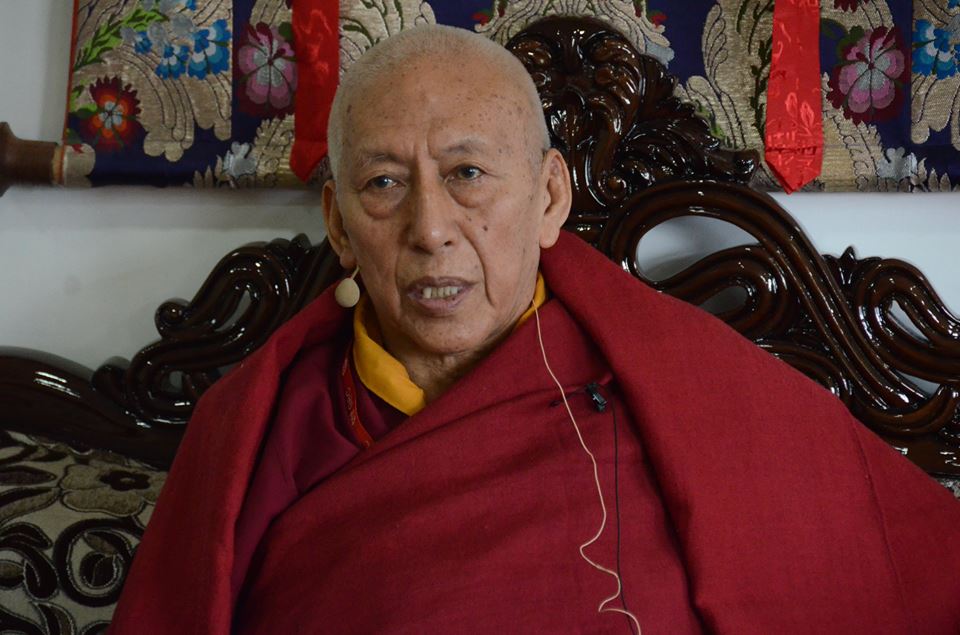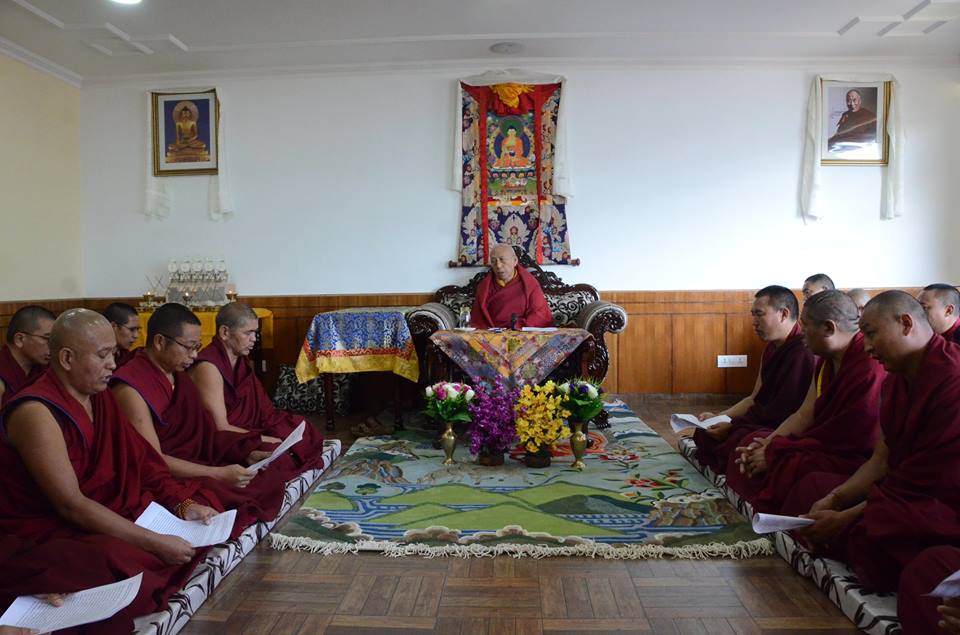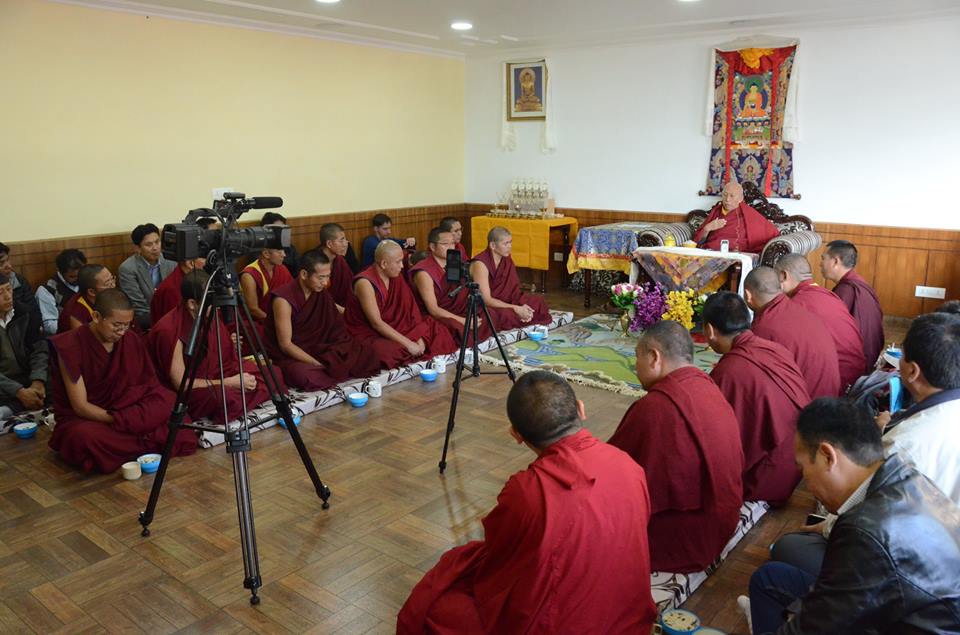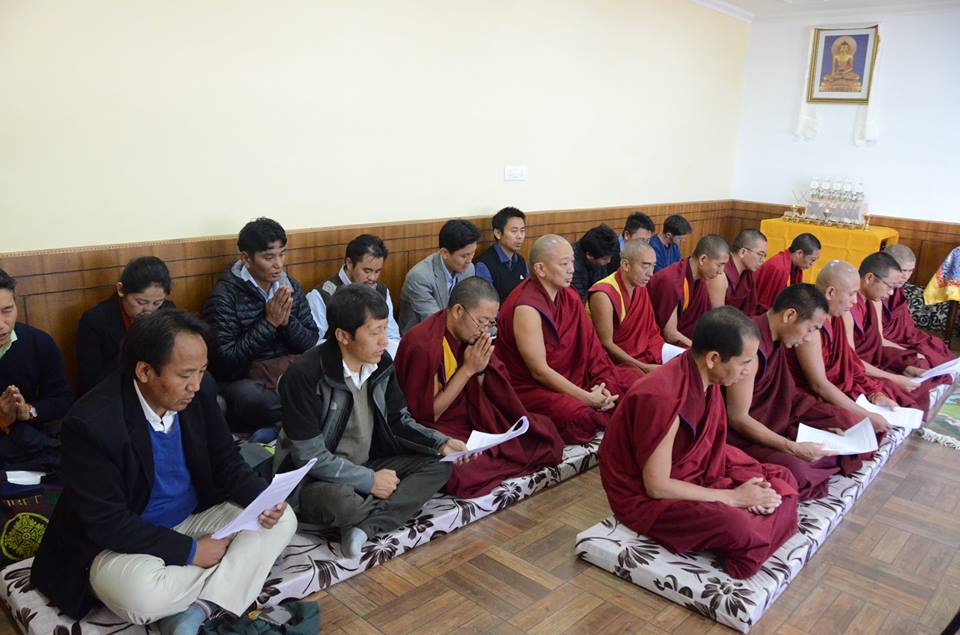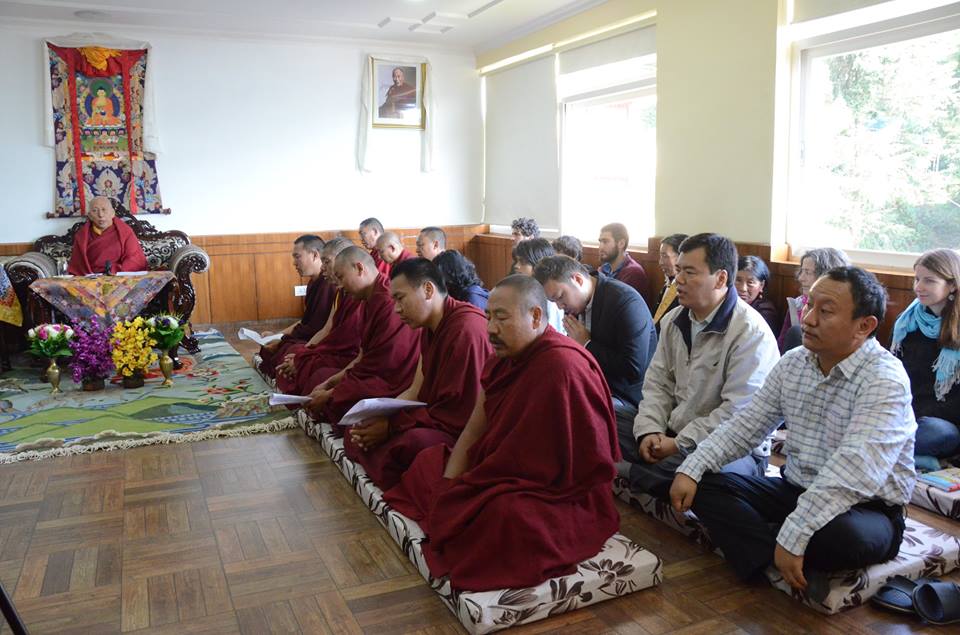Celebration of the 77th Birthday of His Eminence Prof. Samdhong Rinpoche
(Also on the occasion, a talk and the launch of the new volume of Collected Works)
5 November 2016
Organised by LHA Institute for Social Work and Education, Dharamshala, a celebration ceremony was convened for the 77th Birthday of His Eminence Prof. Samdhong Rinpoche, in the conference hall of the institute.
With elaborate offerings to Three Jewels set on the altar, the event began with prayers, and serving of tea and ceremonial rice. Thereafter, at the request of LHA Institute, His Eminence Prof. Samdhong Rinpoche gave a talk—first in Tibetan, followed by in English—on the theme of “The ways of maintaining motive, and carrying out works by social-services workers.” Those who attended the event comprised of many dignitaries from the various monasteries, non-governmental ogranisations, and others.
Subsequent to the talk there followed the launch of Volume 7 of the Collected Works of His Eminence Prof. Samdhong Rinpoche, comprising of His Eminence’s speeches, writings, interviews, etc. (See separate report.)
The Ancestral Model School (Peton School), Gangchen Kyishong, Dharamshala, also convened a formal function and a cultural show of dances and songs, in celebrating His Eminence Prof. Samdhong Rinpoche’s 77th Birthday.
Outside Dharamshala, people in many parts of the world had celebrated and honoured His Eminence Prof. Samdhong Rinpoche’s 77th birthday. In Varanasi, the disciples at Sarnath, in dedication towards continued long life of His Eminence Rinpoche, did releasing of fish—a generosity of freedom from fear, and saving lives—and offered meals to the poor; in the United States the Tibetan organisation Youth for the Middle Way Approach (Y4U), Minnesota, celebrated the birthday, with a special luncheon to the students of Tibetan Culture School; at Sera Je Secondary School the Supplication-Prayer Requesting His Eminence to Kindly Live Long was recited;and special prayers were said by the venerable monks at Tsawa་Khangtsen, of Drepung Loseling Monastic Univsersity, southern India. In various parts of Tibet too people celebrated and honoured His Eminence’s birthday with fervent prayers and setting animals free.
In the talk requested by LHA Institute, on the theme of “The ways of maintaining motive, and carrying out works by social-services workers” His Eminence Prof. Samdhong Rinpoche began with these backgrounds:
Regarding social service, for us Buddhists most of spiritual and worldly activities one does anyway would be inclusive to social service; more so in the Great Vehicle teachings, since there is not any deed of a bodhisattva that is not for the welfare of all sentient beings and for the society, all that a bodhisattva does would be social service. Yet, what these days is described as “social service” that has fairly recently come to flourish as “social service,”or “social work,” has spread from the West, a new word, for the last two hundred or so years.
In general, modern science and the most of the modern subjects (fields of knowledge) do not have a long history; the entire modern subjects (fields of knowledge) have developed within the last three hundred years at the most and a hundred years at the minimum. Of the modern subjects, one new subject is “sociology” or “social science,” which has been in flourish for just over two hundred years.In eighteenth, nineteenth and twentieth century most of the Eastern nations were ruled by colonial powers—England, Portugal and some European countries—and most of the modern subjects for studies that are in the East these days were brought from the West, that perhaps there is not any modern subject that is a development from the local ancient culture. What is taught in the modern universities in India and other countries of the East as “sociology” or “social sciences”were structured according to the Western society, perhaps there is not a social science that is based on Eastern society.
That’s why there are experts in India who say that the present social sciences are not suitable to the society here of the country, that an indigenous social science based on Indian society needs to be developed. But they are few in strength. Of them, the late Prof. A. K. Saran, who passed away some years ago, was a great adept, outstanding in the fields of education and research. He refuted the entire Western social sciences from their foundation, and gave much guidance for the need of a new Eastern social science; this movement is at its initial stage, perhaps it is not impossible that in future, in several hundred years’ time, there may develop an Eastern social science.
Within social sciences is social service, or termed differently as “social work,” which has come about latter to social sciences in development. Of the old Indian universities there are many where Social Sciences is a subject one can study, but not social service or social work. The latter subject came about only in the early twentieth century; for instance, in Banaras (Varanasi), at the Banaras Hindu University (BHU) there is the Department of Social Sciences but not of social service or social work; since Kashi Vidyapit University was established later it has separate departments: Department of Sociology and a separate Department of Social Works; the two have become separate subjects.
What these days we Tibetans use, the terms “chi-tsok zhab-shu” (spyi-tsoks zhabs-zhu; social service) or “chi-tsok ja-wa” (spyi-tsoks-bya-wa; social work) is perhaps taken from the West’s “social work,” or “social service.” In 1966-67, when I was at Dalhousie, there was a lady by the name of Ms. Barbara, who had come from London; she had completed her studies on social service. Along with a certain Mr. Choephel something, one of the Secretaries, started in the exile Tibetan society a section of Social Service. Since then came in the exile society “social service” or “social work.”
These days—should it be called as looking up at a positive model, or imitating—there are many Tibetans engaged in social service and social works. Many of them do not clearly know about serving others through the path of generosity and morality, nor knowing much of the modern Western principles of social service and social work; merely in label it may be called “social service,”in carrying out of the works they must be doing things to benefit the society; but there are many who have become lacking in background with principles. As such, those who are engaged in social service in the Tibetan society, even if they may not have vast and deep understanding of the principles of service of Buddhist perspective and the modern secular principles of social service and social work, it is important that they are familiar with the two. If these are present, then since there is the background support of principles with any social work one does, there would not be fleeting temporariness subject to change by factors. If there is clear vision of the initial objectives, not ignorant of the ways of achieving the objectives, and the resources well gathered, it would become a qualified social service.
After the above words on the background, His Eminence pointed out in great detail the two kinds of social service: religious social service and secular social service. Likewise, His Eminence Rinpoche gave wonderful insights into ways of maintaining the motive, and carrying out of social service. Citing important discourse of Buddha Medicine-Teacher Sūtra Rites, His Eminence listed the seven types of people who need to be specifically cared for. These and many insights were presented in the Talk, which can be viewed in full here at the Facebook link.
